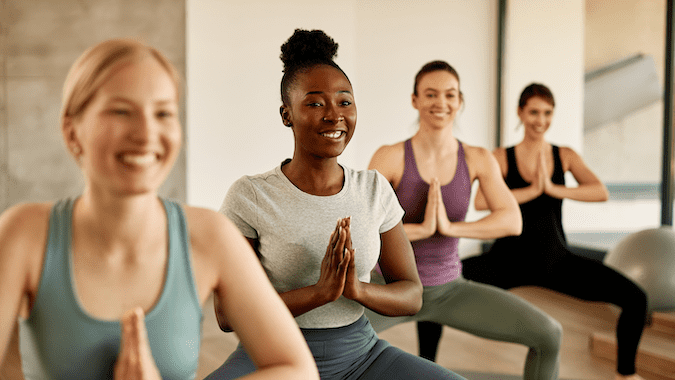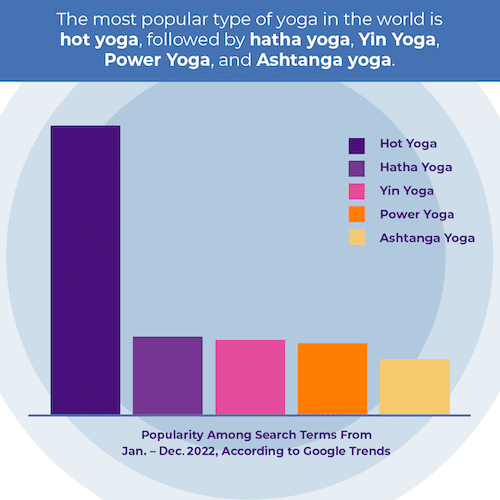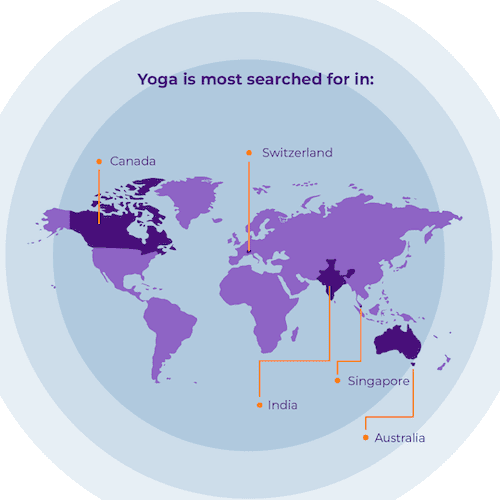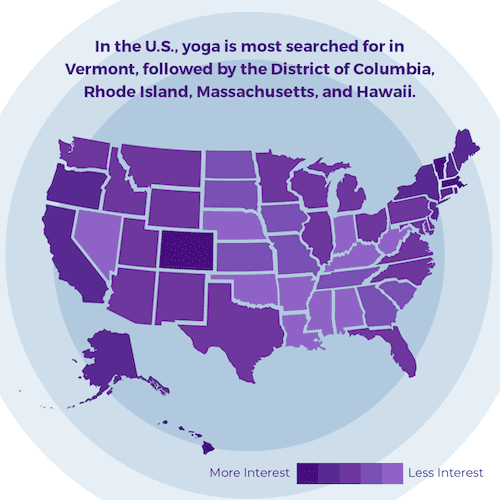
There’s no doubt that yoga is gaining popularity, but you may be asking yourself, what is the most popular type of yoga? Where is each type most popular in the U.S. and around the world? And for those who are interested in trying it themselves, how can you practice these styles of yoga safely?
For decades, I’ve been devoted to the mission of making quality, ethical yoga more accessible. I’ve worked with thousands of clients and hundreds of students training to become yoga teachers or yoga therapists themselves. I’m happy to share my insights about how to practice yoga safely and avoid injury—which is more common than you might think!
Take a look at the data on the most popular types of yoga below, along with my tips for how to practice them safely.

The most popular type of yoga in the world is hot yoga, based on data from 2022. The next most popular types of yoga are hatha yoga, Yin Yoga, Power Yoga (which is another heated yoga), and Ashtanga yoga, respectively.
To see which country is most interested in each style of yoga, check our chart below.
| Type of Yoga | Most Interested Country |
| Acro Yoga | Austria |
| Aerial Yoga | Greece |
| Anusara Yoga | Switzerland |
| Ashtanga Yoga | Norway |
| Bikram Yoga | Australia |
| Hatha Yoga | Singapore |
| Hot Yoga | New Zealand |
| Iyengar Yoga | New Zealand |
| Jivamukti Yoga | Norway |
| Kundalini Yoga | Switzerland |
| Prenatal Yoga | Singapore |
| Power Yoga | United States |
| Restorative Yoga | Canada |
| Sivananda Yoga | Austria |
| SUP Yoga | Switzerland |
| Vinyasa Yoga | Switzerland |
| Yin Yoga | Netherlands |
A few more interesting facts about this global data are:
Users tend to search for hot yoga in person more than through video. “Hot yoga near me,” one of the top related queries for hot yoga, was searched nearly twice as much as “hot yoga video,” another top related query.
The highest interest in Yin Yoga is found in Northern Europe. The Netherlands were the country where Yin Yoga had the highest search popularity, followed by Denmark and Sweden.
The peak global popularity for hot yoga, prenatal yoga, restorative yoga, Ashtanga yoga, and Kundalini yoga was in January. Hot yoga also peaked in its popularity in December.
The peak global popularity for Power Yoga, Bikram Yoga, Iyengar Yoga, aerial yoga, and Acro Yoga was in February. Power Yoga peaked in its popularity in the final week of February and first week of March, as well as in December.
The peak global popularity for Sivananda Yoga was in March, with significantly less interest the rest of the year.
Global interest in SUP Yoga climbed in the summer, with interest in the query “sup yoga near me” increasing 250% in June and July. But interest dropped off during the rest of the year.

The most common type of yoga in the U.S. is hot yoga, based on data from 2022. The next most common types of yoga are Power Yoga and Bikram Yoga (both heated as well), Yin Yoga, and Vinyasa Yoga, respectively.
To see which U.S. region is most interested in each style of yoga, check our chart below.
| Type of Yoga | Most Interested U.S. Region |
| Acro Yoga | Colorado |
| Aerial Yoga | Hawaii |
| Anusara Yoga | District of Columbia |
| Ashtanga Yoga | District of Columbia |
| Bikram Yoga | Vermont |
| Hatha Yoga | Hawaii |
| Hot Yoga | Vermont |
| Iyengar Yoga | Hawaii |
| Jivamukti Yoga | New York |
| Kundalini Yoga | New Mexico |
| Prenatal Yoga | District of Columbia |
| Power Yoga | Rhode Island |
| Restorative Yoga | District of Columbia |
| Sivananda Yoga | New York |
| SUP Yoga | Colorado |
| Vinyasa Yoga | District of Columbia |
| Yin Yoga | Maine |
A few more interesting facts about this U.S. data are:
In addition to being the most popular type of yoga in the U.S., hot yoga was the only style that registered search data for all 50 States and the District of Columbia.
The peak U.S. popularity for Yin Yoga, Vinyasa Yoga, Ashtanga yoga, and hatha yoga was the week of March 27–April 2. Sivananda Yoga and aerial yoga also hit their peak U.S. search popularity in March.
December and January were also peak search times for several types of yoga. Hot yoga, Power Yoga, prenatal yoga, Acro Yoga, Anusara Yoga, Kundalini yoga, and restorative yoga all hit their peak U.S. search popularity in December or January.
Jivamukti Yoga was only searched enough to register search data in 3 U.S. regions: New Jersey, New York, and California.
Sivananda Yoga was only searched enough to register search data in 5 U.S. regions: New Jersey, New York, Illinois, California, and Florida.

More than 300 million people practice yoga around the world. Yoga is most searched for in Switzerland, followed by India, Singapore, Canada, and Australia, based on data from 2022. Globally, the peak popularity of searches for yoga last year occurred during the week of June 19–25.

In the U.S., more than 28 million people practice yoga. Yoga is most searched for in Vermont, followed by the District of Columbia, Rhode Island, Massachusetts, and Hawaii, based on data from 2022. Americans searched for yoga the most last year in the first week of January.
A study published in the Orthopaedic Journal of Sports Medicine found that the rate of yoga-related injuries increased from 2001 to 2014, with a total of 29,590 yoga-related injuries reported from hospital emergency rooms in that time. More recently, a study published in the Journal of ISAKOS found that about two-thirds of yoga-related musculoskeletal injuries impact the lower extremities (hamstring, knee, hip, ankle, foot, or toe).
Whether you’re just getting started with yoga for the first time or you’ve been practicing for years, it’s important to take proper precautions in order to practice yoga safely. The best way to learn how to practice yoga safely is through one-on-one yoga sessions. This allows you to work closely with a yoga expert who can focus on your unique needs.
By contrast, if you practice yoga in a group setting, you won’t have the same opportunities for personal attention from the instructor. Some people in your group class may be stronger and able to do more repetition, while others may fatigue faster. If you push yourself too hard, you could injure yourself, making it important to know your limits and listen to your body if you ever practice yoga in a group.
Practicing yoga safely relies heavily on your unique circumstances, the yoga instructor or yoga therapist you work with, and your ability to receive personalized attention. Even if a specific style of yoga is more susceptible to certain kinds of injuries, you may find a yoga teacher or yoga therapist who can help you practice it safely and avoid those injuries.
To learn about common injuries for the most popular types of yoga, check out my advice below.
Ashtanga yoga is known for being active and energetic. Those who practice Ashtanga yoga typically follow a specific sequence of poses, with vinyasa transitions in between.
If you want to practice Ashtanga yoga safely, it’s important to keep in mind that those series of poses will not be safe or effective for everyone. Don’t push yourself too hard, hold a pose too deep or too long, or make yourself do something that could injure you.
In particular, some of the alignment points in Ashtanga yoga may not work well for every body type. In some cases, Ashtanga yoga can involve over-twisting, which may result in injury.
Bikram Yoga is a type of hot yoga, performed in a room that is set to 105° F (41° C) with 40% humidity. It is meant to promote exercise and fitness with a fixed sequence of 26 yoga poses.
As with Ashtanga yoga, any type of yoga that prescribes specific poses for everyone will run the risk of injury for those who are not well-suited to those poses. In order to practice Bikram Yoga safely, you need to assess whether you should perform each pose and adjust accordingly.
Hot yoga, including Bikram Yoga, is usually not safe for people with high blood pressure or heart conditions. In addition, I have observed that some of the cues in Bikram Yoga can be anatomically incorrect. For example, one client still experiences issues with her neck as a result of Bikram Yoga, despite going more than a decade without practicing it.
Hatha yoga uses physical practices to maintain and direct one’s energy. It can involve using yoga poses for exercise, as well as practicing a specific diet, breathing techniques, meditation, ethics, and spirituality. Many different traditions fall under the umbrella of hatha yoga.
While hatha yoga can be many things, one common issue I’ve observed with hatha yoga at a gym or general yoga studio is it may or may not have good alignment instruction. Some instructors are great, but if you want to practice hatha yoga safely, you shouldn’t automatically assume that the instructor knows how to keep you safe.
For example, you might get a yoga instructor who was trained in a certain lineage that does things a specific way, which may not be safe for everyone. A couple common examples are flattening your neck out or staying in poses that keep your hips locked.
Hatha yoga is frequently performed in general group classes, making it readily available to many people, but restricting the instructor’s ability to meet each individual’s specific limitations and needs.
Hot yoga is a style of yoga that is meant to be practiced in hot, humid conditions, typically as a form of exercise. Bikram Yoga and Power Yoga are examples of hot yoga. The temperature for hot yoga can range from around 80–100° F (27–38° C).
One major risk of hot yoga is exercising in the high heat and humidity. Some people cannot practice hot yoga safely due to these conditions. Hot yoga may not be safe for those with high blood pressure or heart conditions. If you are pregnant, you may want to check with a doctor before performing hot yoga, as you could face a higher risk of lightheadedness, exhaustion, and fainting in these conditions.
Additionally, by warming up your body with hot yoga, you may be more flexible than usual. If you aren’t careful, this can lead to overstretching and injury. For people who are more flexible or have given birth recently, you may be at greater risk of potentially overstretching with hot yoga. Make sure you know your body’s limits so you don’t accidentally surpass them in a heated environment where you may not get the signals your body would normally send if it were being pushed too far.
Power Yoga, like Bikram Yoga, is a type of hot yoga. It is practiced under hot and humid conditions, and it tends to be an energetic form of exercise.
As with any type of hot yoga, you run the risk of overheating, experiencing exhaustion, and even fainting when you exercise in high temperatures and humidity. For those who have high blood pressure or heart conditions, it may not be safe to practice Power Yoga. Someone who is pregnant may also want to abstain from Power Yoga, as they may be more susceptible to becoming lightheaded, exhausted, or fainting under these conditions.
Heat can improve flexibility and range of motion while reducing pain. On the surface, this seems like a good thing, but it can mean that some of your body’s usual safety mechanisms aren’t as effective. You may not experience the pain you usually would from overstretching, which can lead to injury. In order to practice Power Yoga safely, you must be careful not to stretch too deeply or repeatedly.
Vinyasa Yoga can describe a number of different yoga styles. If you practice Vinyasa Yoga, you will flow from one yoga post into the next, both in terms of your movement and your breathing. In general, Vinyasa Yoga tends to be faster paced, which can make it more physically demanding.
While Vinyasa Yoga can be many different things, if you’re practicing a more fast-paced and physically challenging style, you run the risk of repeating the same motions over and over resulting in injury. Some people may also struggle with not being able to hold their alignment.
In particular, I’ve seen some Vinyasa Yoga practices overuse Chaturanga. To perform this pose, you get into a low plank position, which can be taxing on your abdominal muscles, back, arms, and wrists. In Vinyasa Yoga, it is sometimes overused as a transition between poses, such as when you’re returning to Downward Dog Pose or performing an advanced Sun Salutation.
If you overuse Chaturanga, you could hurt your shoulders or wrists. It takes a lot of strength to perform, and fatigue can occur.
If you want to practice Vinyasa Yoga safely, make sure you are aware of your body and its limits. Take a break if you get too tired or modify poses as needed, such as by using blocks or putting your knees on the ground during Chaturanga.
Yin Yoga is a slow-paced type of yoga. It involves holding yoga poses for longer periods of time and can be more relaxing and meditative.
Yin Yoga may be used to target connective tissues (joints, ligaments, tendons, or fascias) in order to improve flexibility, mobility, and circulation. It is the opposite of Yang Yoga, which is more active and energetic.
Although Yin Yoga is meant to be restorative, you can overstretch your connective tissues if you stay in a single position for too long. Sometimes in Yin Yoga, the poses may also be too deep of a stretch for certain people’s bodies to maintain for the length of the hold. The mental challenges of holding poses for a longer period of time or in certain positions can be an issue for some.
While yoga blocks, pillows, cushions, and other bolsters can sometimes help to modify certain yoga poses, even these aids may not be enough to allow certain people to hold a position for a sustained period of time. Personally, one of my biggest injuries came from a Yin seminar in which I stayed in Triangle Pose too deep for too long.
Don’t go to your extremes in any of these poses if you want to practice Yin Yoga safely. Everyone has their own threshold for what’s safe for them, so take care not to exceed it.
At Breathing Deeply Yoga Therapy, we offer training to become a certified yoga therapist or yoga teacher. Our programs are designed to meet you at any skill level, whether you’re just starting out, have your 200-hour teacher training, or are ready for advanced training and C-IAYT certification.
We pride ourselves on making yoga more accessible through quality, ethical training programs. Learn more about our courses and apply online today!
In order to determine the popularity of different types of yoga globally and in the United States, search data was retrieved from Google Trends. The date range for this data was January 1, 2022 through December 31, 2022, and this data was collected on January 18, 2023.
Brandt talks about common questions applicants have about the Breathing Deeply Yoga Therapy Program. Tune in to get the full program details.
Sign-up to receive the Breathing Deeply yoga therapy newsletter and our latest news and updates
"*" indicates required fields
Friends in Yoga, The way we perceive the world is a curious thing. Is it on fire or getting better? Are we facing our challenges or shying away from them? Are we functioning from the present or some altered reality based on past experiences? The teachings tell us that reality is ultimately timeless. The vibration […]
There’s no doubt that yoga is gaining popularity, but you may be asking yourself, what is the most popular type of yoga? Where is each type most popular in the U.S. and around the world? And for those who are interested in trying it themselves, how can you practice these styles of yoga safely? For […]
Friends in Yoga, Sitting on a cushion, taking a yoga class, chanting a mantra before your morning coffee…no one would call these radical acts. They are small choices that we make to better ourselves. The motivation to practice often takes form by our desire to be healthier, to be more focused, to connect with our […]
Copyright © 2024 Breathing Deeply
The Breathing Deeply Advanced Yoga Therapy Program is accredited by the International Association of Yoga Therapists.
© Breathing Deeply |
